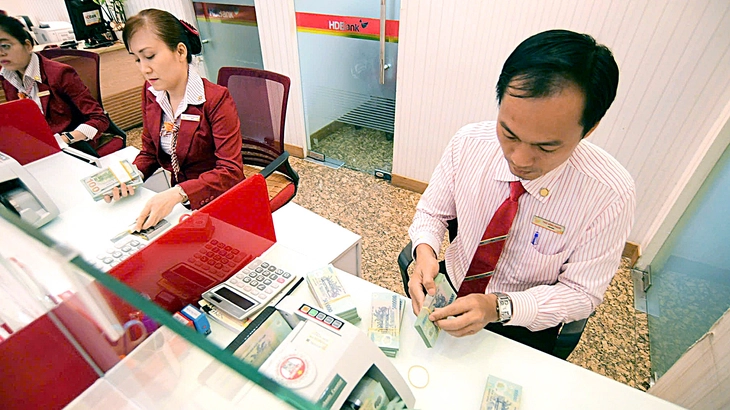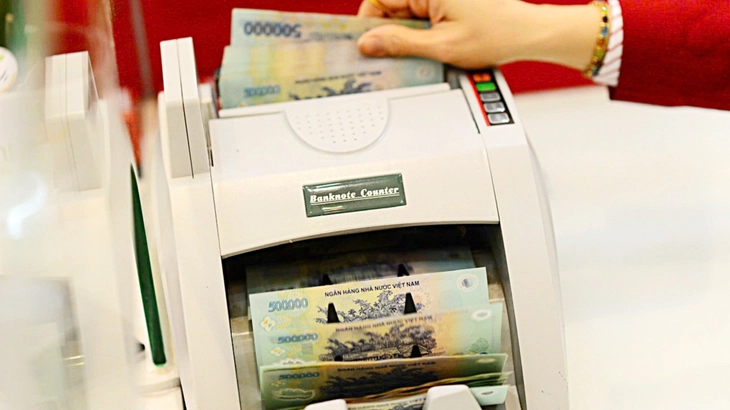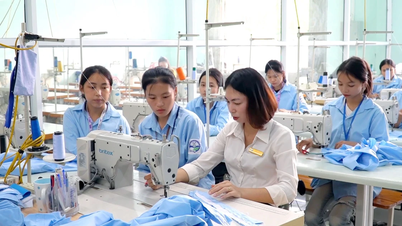
Although credit has increased many times compared to previous years, inflation in the first 5 months of the year is still within the allowable level - Photo: QUANG DINH
However, behind the abundant amount of money pumped into the economy are risks of bad debt, asset bubbles and macroeconomic imbalances if not tightly controlled...
Credit accelerated from the beginning of the year
According to data from the State Bank, as of the end of May, credit in the entire economy increased by 6.52%, significantly higher than the 2.41% in the same period in 2024. It is estimated that in the first 5 months of the year, outstanding credit in the entire economy increased by more than 1 quadrillion VND, to more than 16.6 quadrillion VND - a record increase in outstanding credit in the same period in recent years.
Talking to Tuoi Tre, Mr. Le Hoai An, a banking and finance expert and founder of Integrated Financial Solutions Joint Stock Company, commented that the injection of 1 million billion VND in the first 5 months of this year surprised many people, but if we look back, on average each year recently we still injected about 2 million billion VND. The difference this year is that the disbursement speed increased from the beginning of the year.
"In previous years, credit was often slow at the beginning of the year and then broke out in the second half of the year. This year, the State Bank has loosened credit room since January to support the growth target," Mr. An said.
Ms. Tran Thi Khanh Hien, director of research at MB Securities (MBS), said that credit across the system began to increase strongly from March, thanks to positive sentiment supported by the 8% GDP growth target along with loosened monetary policy targets.
As of June 16, credit had increased by 6.99% compared to the beginning of the year, higher than the 3.75% in the same period last year. According to MBS experts, credit at listed commercial banks did not fluctuate much compared to the previous quarter; in which, the group of private joint-stock commercial banks had a better growth rate than the group of state-owned banks.
"Banks with good credit growth in the first quarter of the year such as MSB, Eximbank, VPBank,SHB , VietinBank continued to grow in the second quarter. The low interest rate environment, focusing on corporate customers, continued to be the main driving force of credit this quarter," said Ms. Hien.
Regarding the outlook for the end of the year, Ms. Hien forecasts that credit growth could reach about 16 - 17%. This is considered a good growth rate, showing that money is still circulating in the economy.
Borrow less from listed companies
According to the State Bank's report, as of May 28, the total outstanding credit balance of the entire economy reached more than 16.6 million billion VND, an increase of 6.32% compared to the beginning of the year. Analyzing each sector of the economy, it can be seen that some sectors increased lower than the general increase (5.32%) such as: agriculture , forestry and fishery (2.5%), industry and construction (4.51%), trade (4.34%)...
Industry data also shows that credit for listed enterprises has grown quite modestly, not commensurate with the speed of "capital injection" from the banking system.
According to Mr. Le Hoai An, this development reflects that most of the credit flow is going to the unlisted enterprise sector, which is considered to lack transparency in financial information and quality of collateral. In recent years, the group of listed enterprises has not increased their demand for loans. "This also raises questions about the quality of credit growth," Mr. An wondered.
Analysis from the VnDirect research department further reinforces this view. In the first quarter of 2025, financial indicators show that businesses are tending to reduce leverage. Specifically, interest expenses decreased to 6.1% (down 0.5 percentage points compared to the previous quarter), while the D/E ratio (debt/equity) decreased to 71.9% (down 3.5 percentage points).
According to experts from VnDirect, although the Government is making efforts to lower interest rates to reduce borrowing costs, actual credit demand from the business sector remains quite quiet. The main reason comes from the fact that many businesses are restructuring their financial portfolios and are more cautious in expanding loans amid a volatile economic environment.
Meanwhile, Ms. Tran Thi Khanh Hien said that the more than 1 million billion VND "pumped" out includes loans for debt restructuring and debt rollover purposes, not entirely new disbursements.
A notable trend is that many businesses have bought back matured bonds and borrowed from banks at better interest rates than last year. "It is difficult to determine the actual ratio between new loans and debt restructuring in the total of more than 1 quadrillion VND," Ms. Hien said, adding that she could wait for more private investment data for the first 6 months of the year to be announced for further assessments.
Credit is still "carrying" the whole economy
Emphasizing that credit promotion policy continues to be an important tool to stimulate capital flows and support production and business, Mr. Le Van Thanh, research advisor of WiGroup (a corporate financial data company), also warned that the credit-to-GDP ratio had reached 134% by the end of 2024, much higher than similar economies.

Credit is currently increasing quite rapidly and at a high rate in the last 3 months - Photo: Q.D.
This issue was also mentioned by the Governor of the State Bank Nguyen Thi Hong at the recent National Assembly session. According to Ms. Hong, it is important to note that domestic capital depends heavily on bank credit, including medium and long-term capital.
Continuing to rely on bank capital will pose risks and cause consequences for the economy, making it difficult to achieve high growth and sustainability. This is an issue that ministries and sectors in charge of macroeconomic management need to pay close attention to when balancing capital sources for growth targets.
According to data from the Vietnam Banks Association, as of April 10, the average lending interest rate for new loans was 6.34%/year, down 0.6 percentage points compared to the end of 2024. From the end of February 2025, banks simultaneously lowered deposit interest rates, creating conditions to lower lending interest rates, supporting businesses to restore production and business.
Source: https://tuoitre.vn/hon-1-trieu-ti-dong-duoc-bom-ra-nen-kinh-te-ky-1-mung-nhung-van-lo-chat-luong-tin-dung-20250625224621874.htm







![[Photo] Binh Trieu 1 Bridge has been completed, raised by 1.1m, and will open to traffic at the end of November.](https://vphoto.vietnam.vn/thumb/1200x675/vietnam/resource/IMAGE/2025/10/2/a6549e2a3b5848a1ba76a1ded6141fae)






























































































Comment (0)